Leadership in Medical Education: A Case Study & Key Insights
VerifiedAdded on 2023/06/03
|8
|2229
|471
Report
AI Summary
This report examines the critical role of leadership in medical education, highlighting its impact on patient care and healthcare system efficiency. It discusses the evolution of leadership theories, emphasizing the shift from transactional to transformational leadership, and the importance of vision, strategic thinking, and communication. The report presents a case study where a charge nurse's leadership was crucial in managing a critical patient situation, demonstrating the practical application of leadership skills in a stressful medical environment. It concludes that effective clinical leadership is essential for optimal hospital performance and recommends strategies to develop these skills among healthcare professionals. Desklib provides access to this and other solved assignments.
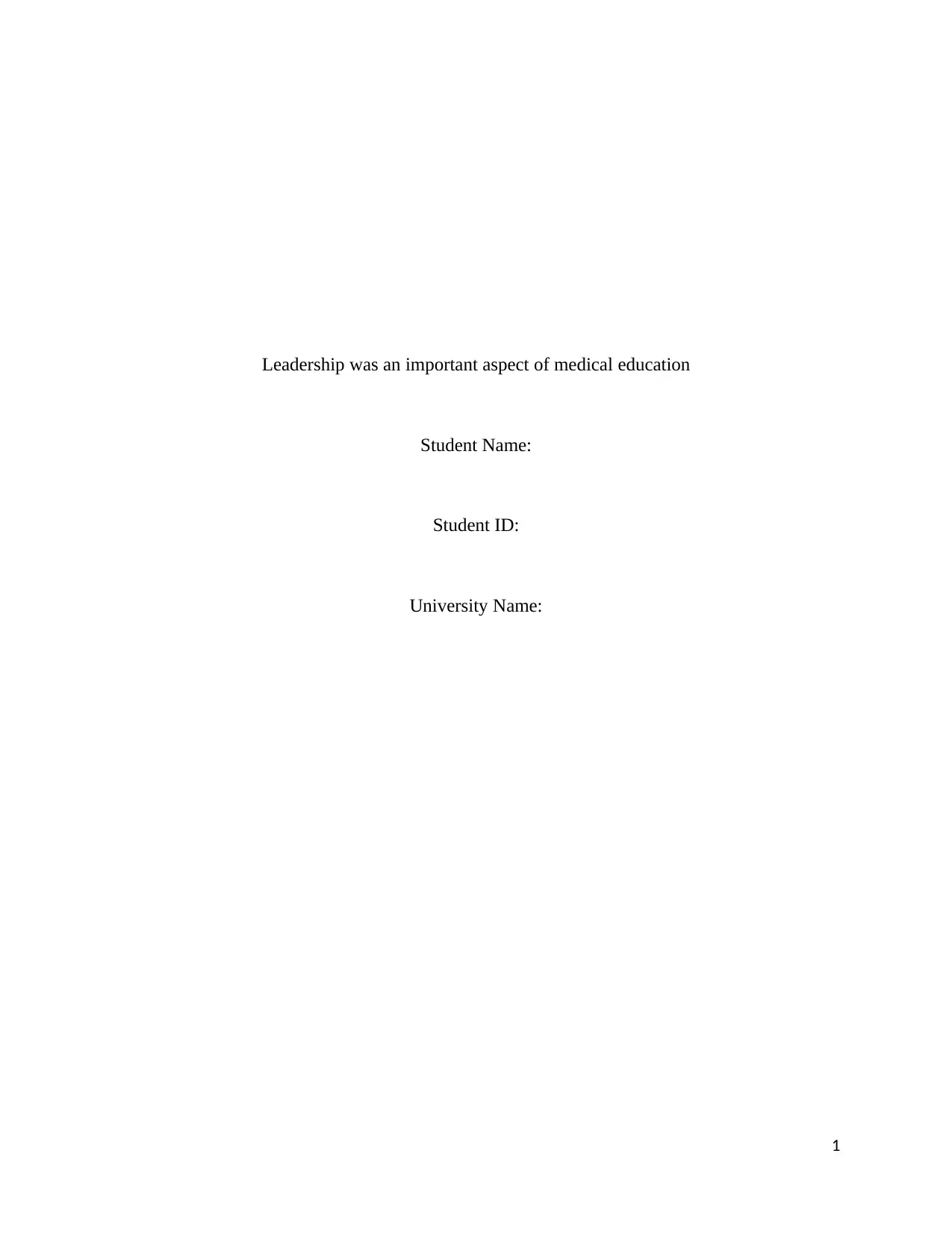
Leadership was an important aspect of medical education
Student Name:
Student ID:
University Name:
1
Student Name:
Student ID:
University Name:
1
Paraphrase This Document
Need a fresh take? Get an instant paraphrase of this document with our AI Paraphraser
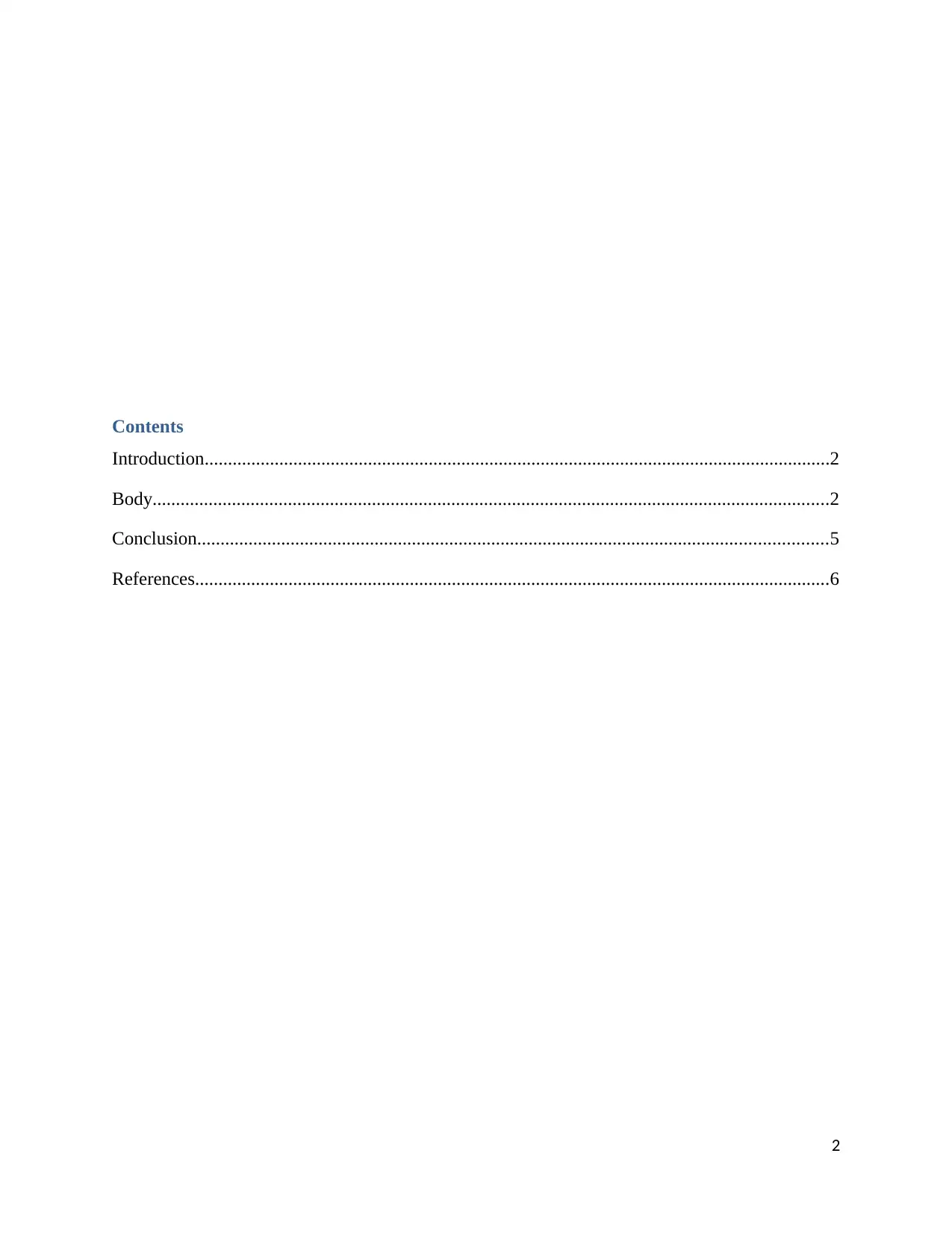
Contents
Introduction......................................................................................................................................2
Body.................................................................................................................................................2
Conclusion.......................................................................................................................................5
References........................................................................................................................................6
2
Introduction......................................................................................................................................2
Body.................................................................................................................................................2
Conclusion.......................................................................................................................................5
References........................................................................................................................................6
2
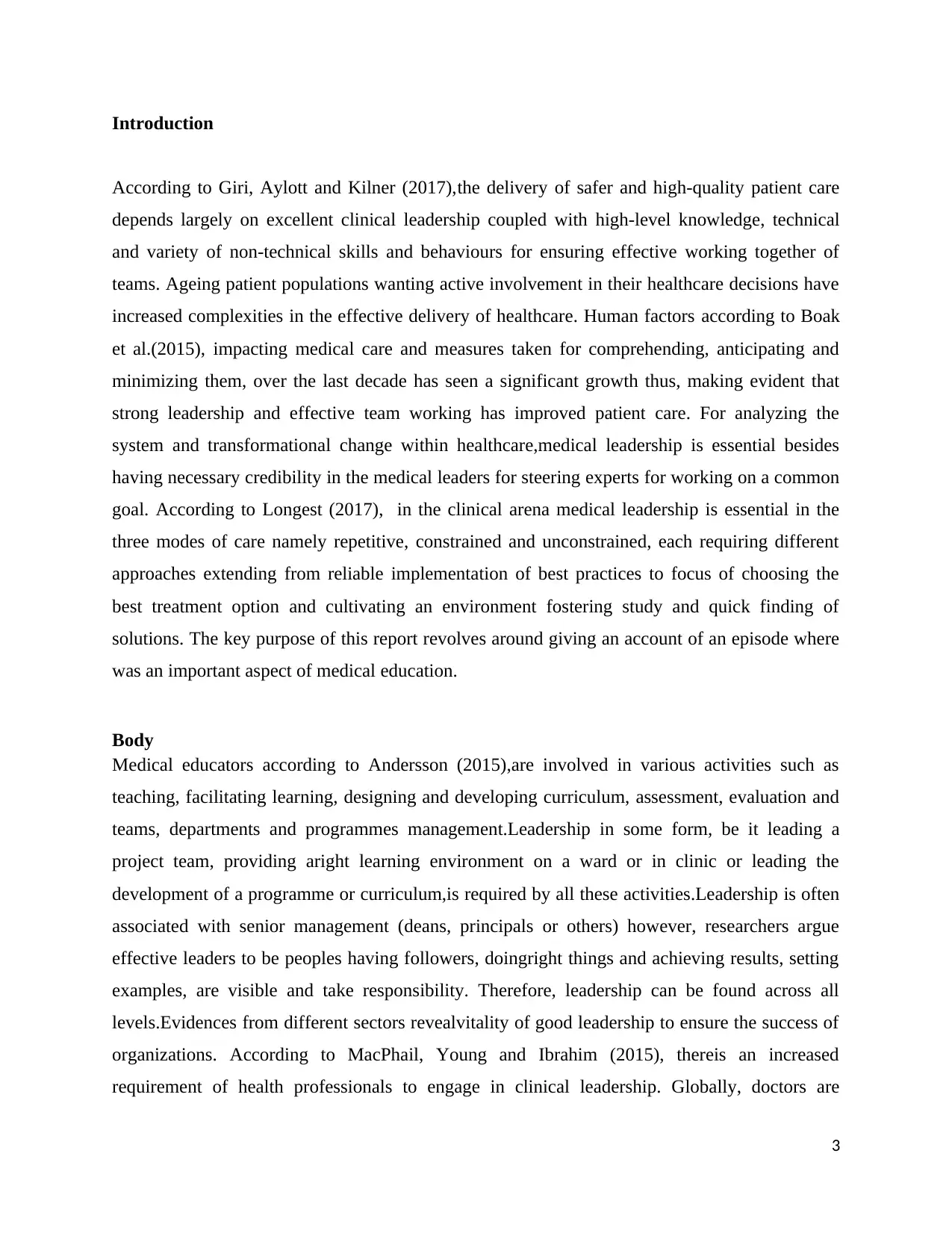
Introduction
According to Giri, Aylott and Kilner (2017),the delivery of safer and high-quality patient care
depends largely on excellent clinical leadership coupled with high-level knowledge, technical
and variety of non-technical skills and behaviours for ensuring effective working together of
teams. Ageing patient populations wanting active involvement in their healthcare decisions have
increased complexities in the effective delivery of healthcare. Human factors according to Boak
et al.(2015), impacting medical care and measures taken for comprehending, anticipating and
minimizing them, over the last decade has seen a significant growth thus, making evident that
strong leadership and effective team working has improved patient care. For analyzing the
system and transformational change within healthcare,medical leadership is essential besides
having necessary credibility in the medical leaders for steering experts for working on a common
goal. According to Longest (2017), in the clinical arena medical leadership is essential in the
three modes of care namely repetitive, constrained and unconstrained, each requiring different
approaches extending from reliable implementation of best practices to focus of choosing the
best treatment option and cultivating an environment fostering study and quick finding of
solutions. The key purpose of this report revolves around giving an account of an episode where
was an important aspect of medical education.
Body
Medical educators according to Andersson (2015),are involved in various activities such as
teaching, facilitating learning, designing and developing curriculum, assessment, evaluation and
teams, departments and programmes management.Leadership in some form, be it leading a
project team, providing aright learning environment on a ward or in clinic or leading the
development of a programme or curriculum,is required by all these activities.Leadership is often
associated with senior management (deans, principals or others) however, researchers argue
effective leaders to be peoples having followers, doingright things and achieving results, setting
examples, are visible and take responsibility. Therefore, leadership can be found across all
levels.Evidences from different sectors revealvitality of good leadership to ensure the success of
organizations. According to MacPhail, Young and Ibrahim (2015), thereis an increased
requirement of health professionals to engage in clinical leadership. Globally, doctors are
3
According to Giri, Aylott and Kilner (2017),the delivery of safer and high-quality patient care
depends largely on excellent clinical leadership coupled with high-level knowledge, technical
and variety of non-technical skills and behaviours for ensuring effective working together of
teams. Ageing patient populations wanting active involvement in their healthcare decisions have
increased complexities in the effective delivery of healthcare. Human factors according to Boak
et al.(2015), impacting medical care and measures taken for comprehending, anticipating and
minimizing them, over the last decade has seen a significant growth thus, making evident that
strong leadership and effective team working has improved patient care. For analyzing the
system and transformational change within healthcare,medical leadership is essential besides
having necessary credibility in the medical leaders for steering experts for working on a common
goal. According to Longest (2017), in the clinical arena medical leadership is essential in the
three modes of care namely repetitive, constrained and unconstrained, each requiring different
approaches extending from reliable implementation of best practices to focus of choosing the
best treatment option and cultivating an environment fostering study and quick finding of
solutions. The key purpose of this report revolves around giving an account of an episode where
was an important aspect of medical education.
Body
Medical educators according to Andersson (2015),are involved in various activities such as
teaching, facilitating learning, designing and developing curriculum, assessment, evaluation and
teams, departments and programmes management.Leadership in some form, be it leading a
project team, providing aright learning environment on a ward or in clinic or leading the
development of a programme or curriculum,is required by all these activities.Leadership is often
associated with senior management (deans, principals or others) however, researchers argue
effective leaders to be peoples having followers, doingright things and achieving results, setting
examples, are visible and take responsibility. Therefore, leadership can be found across all
levels.Evidences from different sectors revealvitality of good leadership to ensure the success of
organizations. According to MacPhail, Young and Ibrahim (2015), thereis an increased
requirement of health professionals to engage in clinical leadership. Globally, doctors are
3
⊘ This is a preview!⊘
Do you want full access?
Subscribe today to unlock all pages.

Trusted by 1+ million students worldwide
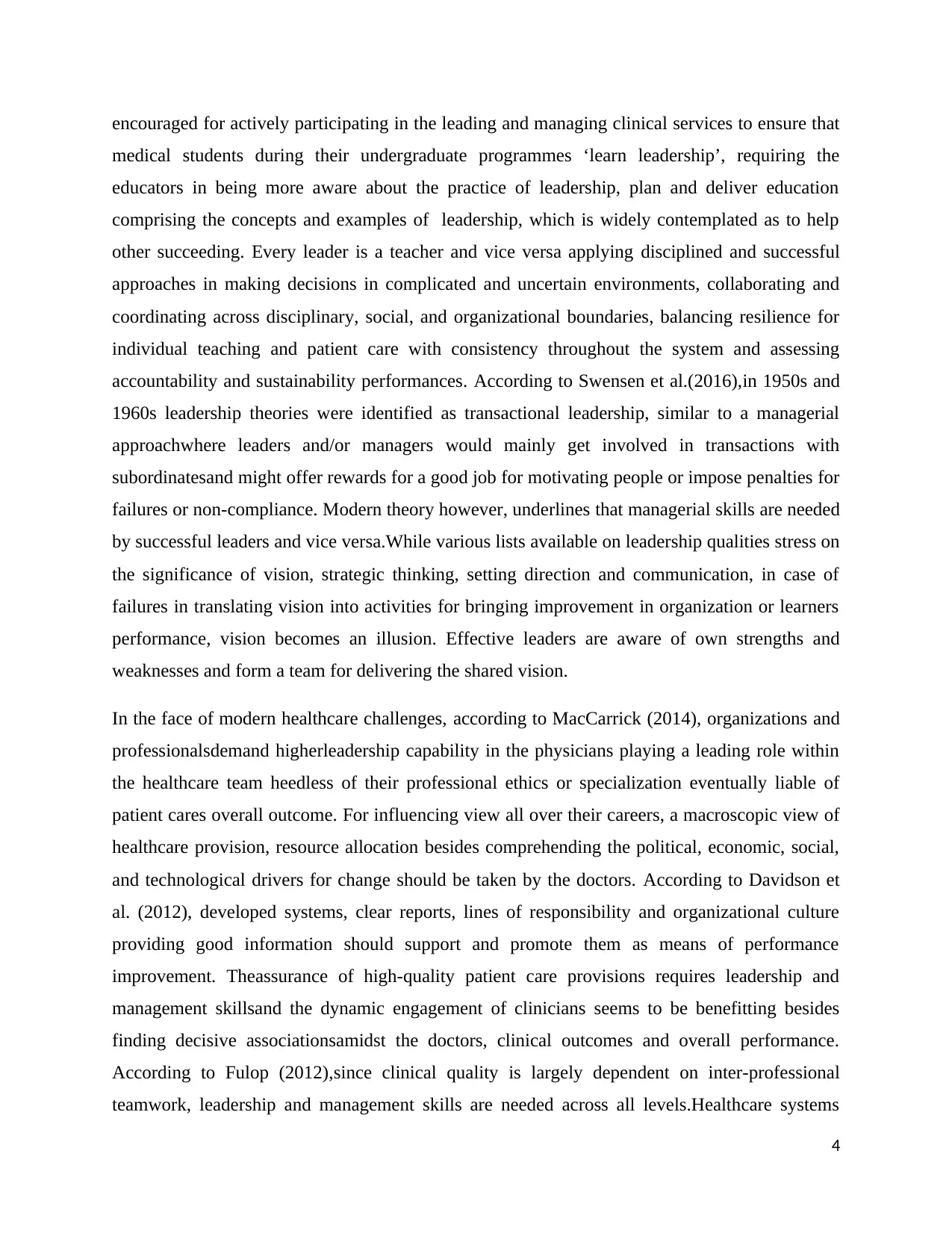
encouraged for actively participating in the leading and managing clinical services to ensure that
medical students during their undergraduate programmes ‘learn leadership’, requiring the
educators in being more aware about the practice of leadership, plan and deliver education
comprising the concepts and examples of leadership, which is widely contemplated as to help
other succeeding. Every leader is a teacher and vice versa applying disciplined and successful
approaches in making decisions in complicated and uncertain environments, collaborating and
coordinating across disciplinary, social, and organizational boundaries, balancing resilience for
individual teaching and patient care with consistency throughout the system and assessing
accountability and sustainability performances. According to Swensen et al.(2016),in 1950s and
1960s leadership theories were identified as transactional leadership, similar to a managerial
approachwhere leaders and/or managers would mainly get involved in transactions with
subordinatesand might offer rewards for a good job for motivating people or impose penalties for
failures or non-compliance. Modern theory however, underlines that managerial skills are needed
by successful leaders and vice versa.While various lists available on leadership qualities stress on
the significance of vision, strategic thinking, setting direction and communication, in case of
failures in translating vision into activities for bringing improvement in organization or learners
performance, vision becomes an illusion. Effective leaders are aware of own strengths and
weaknesses and form a team for delivering the shared vision.
In the face of modern healthcare challenges, according to MacCarrick (2014), organizations and
professionalsdemand higherleadership capability in the physicians playing a leading role within
the healthcare team heedless of their professional ethics or specialization eventually liable of
patient cares overall outcome. For influencing view all over their careers, a macroscopic view of
healthcare provision, resource allocation besides comprehending the political, economic, social,
and technological drivers for change should be taken by the doctors. According to Davidson et
al. (2012), developed systems, clear reports, lines of responsibility and organizational culture
providing good information should support and promote them as means of performance
improvement. Theassurance of high-quality patient care provisions requires leadership and
management skillsand the dynamic engagement of clinicians seems to be benefitting besides
finding decisive associationsamidst the doctors, clinical outcomes and overall performance.
According to Fulop (2012),since clinical quality is largely dependent on inter-professional
teamwork, leadership and management skills are needed across all levels.Healthcare systems
4
medical students during their undergraduate programmes ‘learn leadership’, requiring the
educators in being more aware about the practice of leadership, plan and deliver education
comprising the concepts and examples of leadership, which is widely contemplated as to help
other succeeding. Every leader is a teacher and vice versa applying disciplined and successful
approaches in making decisions in complicated and uncertain environments, collaborating and
coordinating across disciplinary, social, and organizational boundaries, balancing resilience for
individual teaching and patient care with consistency throughout the system and assessing
accountability and sustainability performances. According to Swensen et al.(2016),in 1950s and
1960s leadership theories were identified as transactional leadership, similar to a managerial
approachwhere leaders and/or managers would mainly get involved in transactions with
subordinatesand might offer rewards for a good job for motivating people or impose penalties for
failures or non-compliance. Modern theory however, underlines that managerial skills are needed
by successful leaders and vice versa.While various lists available on leadership qualities stress on
the significance of vision, strategic thinking, setting direction and communication, in case of
failures in translating vision into activities for bringing improvement in organization or learners
performance, vision becomes an illusion. Effective leaders are aware of own strengths and
weaknesses and form a team for delivering the shared vision.
In the face of modern healthcare challenges, according to MacCarrick (2014), organizations and
professionalsdemand higherleadership capability in the physicians playing a leading role within
the healthcare team heedless of their professional ethics or specialization eventually liable of
patient cares overall outcome. For influencing view all over their careers, a macroscopic view of
healthcare provision, resource allocation besides comprehending the political, economic, social,
and technological drivers for change should be taken by the doctors. According to Davidson et
al. (2012), developed systems, clear reports, lines of responsibility and organizational culture
providing good information should support and promote them as means of performance
improvement. Theassurance of high-quality patient care provisions requires leadership and
management skillsand the dynamic engagement of clinicians seems to be benefitting besides
finding decisive associationsamidst the doctors, clinical outcomes and overall performance.
According to Fulop (2012),since clinical quality is largely dependent on inter-professional
teamwork, leadership and management skills are needed across all levels.Healthcare systems
4
Paraphrase This Document
Need a fresh take? Get an instant paraphrase of this document with our AI Paraphraser
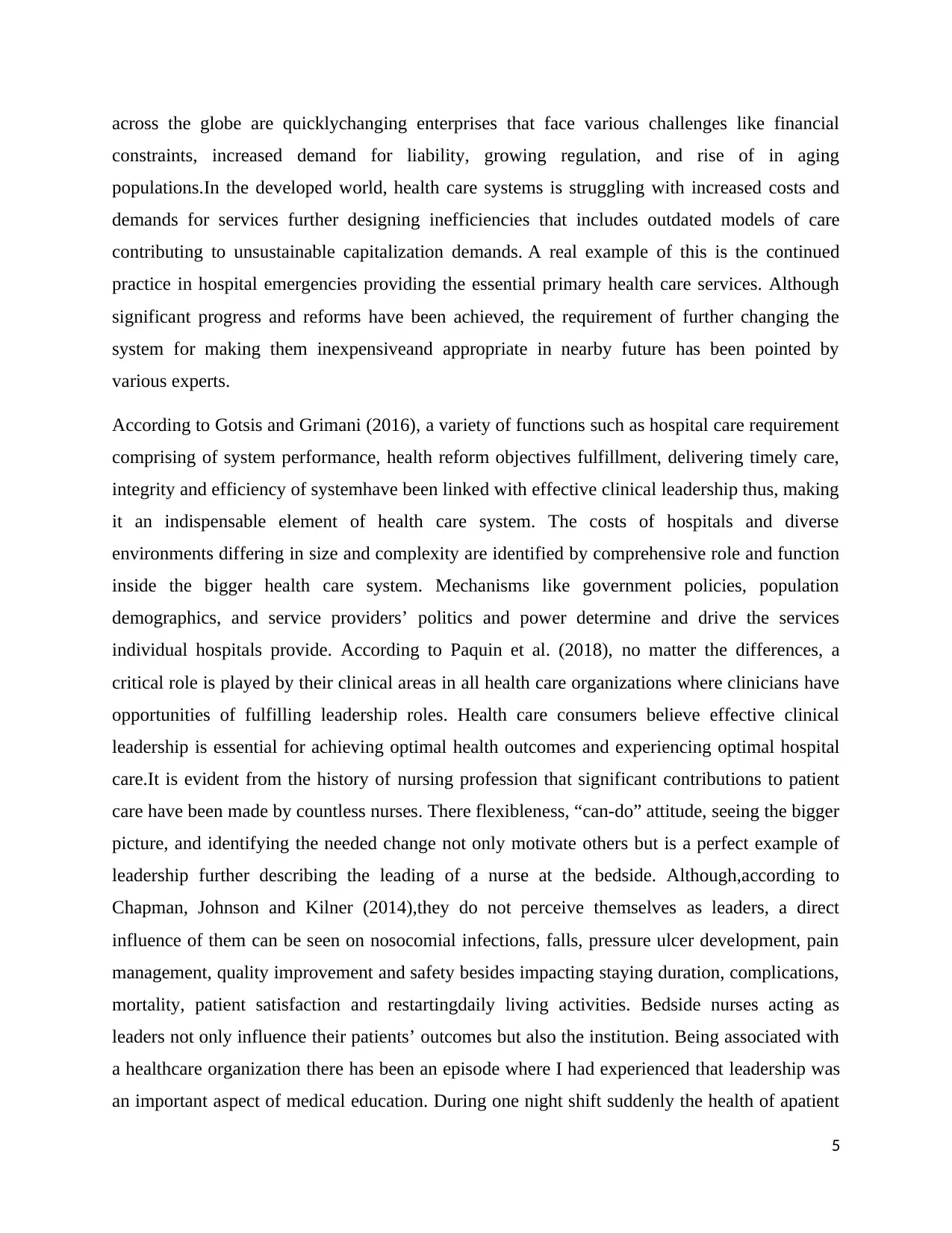
across the globe are quicklychanging enterprises that face various challenges like financial
constraints, increased demand for liability, growing regulation, and rise of in aging
populations.In the developed world, health care systems is struggling with increased costs and
demands for services further designing inefficiencies that includes outdated models of care
contributing to unsustainable capitalization demands. A real example of this is the continued
practice in hospital emergencies providing the essential primary health care services. Although
significant progress and reforms have been achieved, the requirement of further changing the
system for making them inexpensiveand appropriate in nearby future has been pointed by
various experts.
According to Gotsis and Grimani (2016), a variety of functions such as hospital care requirement
comprising of system performance, health reform objectives fulfillment, delivering timely care,
integrity and efficiency of systemhave been linked with effective clinical leadership thus, making
it an indispensable element of health care system. The costs of hospitals and diverse
environments differing in size and complexity are identified by comprehensive role and function
inside the bigger health care system. Mechanisms like government policies, population
demographics, and service providers’ politics and power determine and drive the services
individual hospitals provide. According to Paquin et al. (2018), no matter the differences, a
critical role is played by their clinical areas in all health care organizations where clinicians have
opportunities of fulfilling leadership roles. Health care consumers believe effective clinical
leadership is essential for achieving optimal health outcomes and experiencing optimal hospital
care.It is evident from the history of nursing profession that significant contributions to patient
care have been made by countless nurses. There flexibleness, “can-do” attitude, seeing the bigger
picture, and identifying the needed change not only motivate others but is a perfect example of
leadership further describing the leading of a nurse at the bedside. Although,according to
Chapman, Johnson and Kilner (2014),they do not perceive themselves as leaders, a direct
influence of them can be seen on nosocomial infections, falls, pressure ulcer development, pain
management, quality improvement and safety besides impacting staying duration, complications,
mortality, patient satisfaction and restartingdaily living activities. Bedside nurses acting as
leaders not only influence their patients’ outcomes but also the institution. Being associated with
a healthcare organization there has been an episode where I had experienced that leadership was
an important aspect of medical education. During one night shift suddenly the health of apatient
5
constraints, increased demand for liability, growing regulation, and rise of in aging
populations.In the developed world, health care systems is struggling with increased costs and
demands for services further designing inefficiencies that includes outdated models of care
contributing to unsustainable capitalization demands. A real example of this is the continued
practice in hospital emergencies providing the essential primary health care services. Although
significant progress and reforms have been achieved, the requirement of further changing the
system for making them inexpensiveand appropriate in nearby future has been pointed by
various experts.
According to Gotsis and Grimani (2016), a variety of functions such as hospital care requirement
comprising of system performance, health reform objectives fulfillment, delivering timely care,
integrity and efficiency of systemhave been linked with effective clinical leadership thus, making
it an indispensable element of health care system. The costs of hospitals and diverse
environments differing in size and complexity are identified by comprehensive role and function
inside the bigger health care system. Mechanisms like government policies, population
demographics, and service providers’ politics and power determine and drive the services
individual hospitals provide. According to Paquin et al. (2018), no matter the differences, a
critical role is played by their clinical areas in all health care organizations where clinicians have
opportunities of fulfilling leadership roles. Health care consumers believe effective clinical
leadership is essential for achieving optimal health outcomes and experiencing optimal hospital
care.It is evident from the history of nursing profession that significant contributions to patient
care have been made by countless nurses. There flexibleness, “can-do” attitude, seeing the bigger
picture, and identifying the needed change not only motivate others but is a perfect example of
leadership further describing the leading of a nurse at the bedside. Although,according to
Chapman, Johnson and Kilner (2014),they do not perceive themselves as leaders, a direct
influence of them can be seen on nosocomial infections, falls, pressure ulcer development, pain
management, quality improvement and safety besides impacting staying duration, complications,
mortality, patient satisfaction and restartingdaily living activities. Bedside nurses acting as
leaders not only influence their patients’ outcomes but also the institution. Being associated with
a healthcare organization there has been an episode where I had experienced that leadership was
an important aspect of medical education. During one night shift suddenly the health of apatient
5
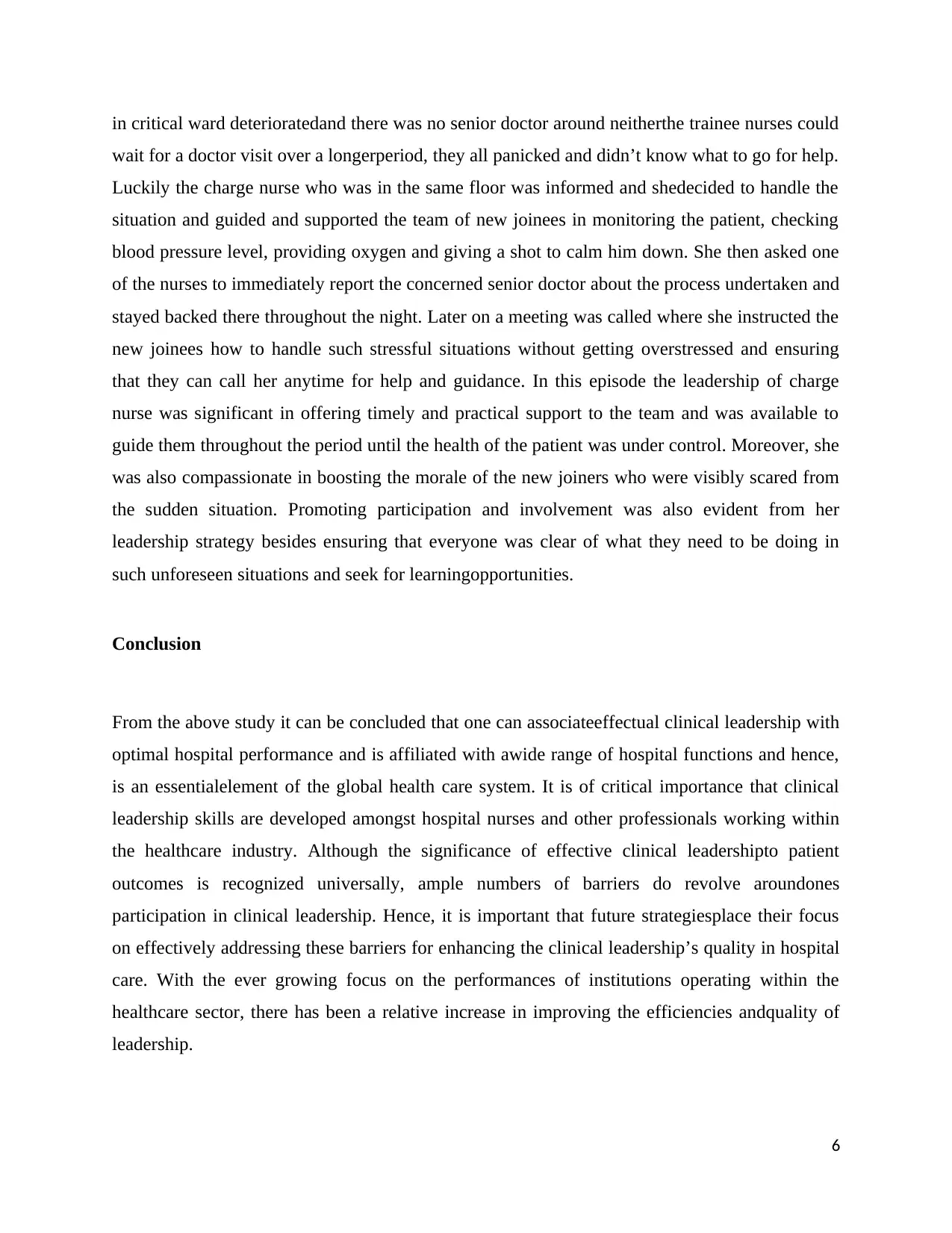
in critical ward deterioratedand there was no senior doctor around neitherthe trainee nurses could
wait for a doctor visit over a longerperiod, they all panicked and didn’t know what to go for help.
Luckily the charge nurse who was in the same floor was informed and shedecided to handle the
situation and guided and supported the team of new joinees in monitoring the patient, checking
blood pressure level, providing oxygen and giving a shot to calm him down. She then asked one
of the nurses to immediately report the concerned senior doctor about the process undertaken and
stayed backed there throughout the night. Later on a meeting was called where she instructed the
new joinees how to handle such stressful situations without getting overstressed and ensuring
that they can call her anytime for help and guidance. In this episode the leadership of charge
nurse was significant in offering timely and practical support to the team and was available to
guide them throughout the period until the health of the patient was under control. Moreover, she
was also compassionate in boosting the morale of the new joiners who were visibly scared from
the sudden situation. Promoting participation and involvement was also evident from her
leadership strategy besides ensuring that everyone was clear of what they need to be doing in
such unforeseen situations and seek for learningopportunities.
Conclusion
From the above study it can be concluded that one can associateeffectual clinical leadership with
optimal hospital performance and is affiliated with awide range of hospital functions and hence,
is an essentialelement of the global health care system. It is of critical importance that clinical
leadership skills are developed amongst hospital nurses and other professionals working within
the healthcare industry. Although the significance of effective clinical leadershipto patient
outcomes is recognized universally, ample numbers of barriers do revolve aroundones
participation in clinical leadership. Hence, it is important that future strategiesplace their focus
on effectively addressing these barriers for enhancing the clinical leadership’s quality in hospital
care. With the ever growing focus on the performances of institutions operating within the
healthcare sector, there has been a relative increase in improving the efficiencies andquality of
leadership.
6
wait for a doctor visit over a longerperiod, they all panicked and didn’t know what to go for help.
Luckily the charge nurse who was in the same floor was informed and shedecided to handle the
situation and guided and supported the team of new joinees in monitoring the patient, checking
blood pressure level, providing oxygen and giving a shot to calm him down. She then asked one
of the nurses to immediately report the concerned senior doctor about the process undertaken and
stayed backed there throughout the night. Later on a meeting was called where she instructed the
new joinees how to handle such stressful situations without getting overstressed and ensuring
that they can call her anytime for help and guidance. In this episode the leadership of charge
nurse was significant in offering timely and practical support to the team and was available to
guide them throughout the period until the health of the patient was under control. Moreover, she
was also compassionate in boosting the morale of the new joiners who were visibly scared from
the sudden situation. Promoting participation and involvement was also evident from her
leadership strategy besides ensuring that everyone was clear of what they need to be doing in
such unforeseen situations and seek for learningopportunities.
Conclusion
From the above study it can be concluded that one can associateeffectual clinical leadership with
optimal hospital performance and is affiliated with awide range of hospital functions and hence,
is an essentialelement of the global health care system. It is of critical importance that clinical
leadership skills are developed amongst hospital nurses and other professionals working within
the healthcare industry. Although the significance of effective clinical leadershipto patient
outcomes is recognized universally, ample numbers of barriers do revolve aroundones
participation in clinical leadership. Hence, it is important that future strategiesplace their focus
on effectively addressing these barriers for enhancing the clinical leadership’s quality in hospital
care. With the ever growing focus on the performances of institutions operating within the
healthcare sector, there has been a relative increase in improving the efficiencies andquality of
leadership.
6
⊘ This is a preview!⊘
Do you want full access?
Subscribe today to unlock all pages.

Trusted by 1+ million students worldwide
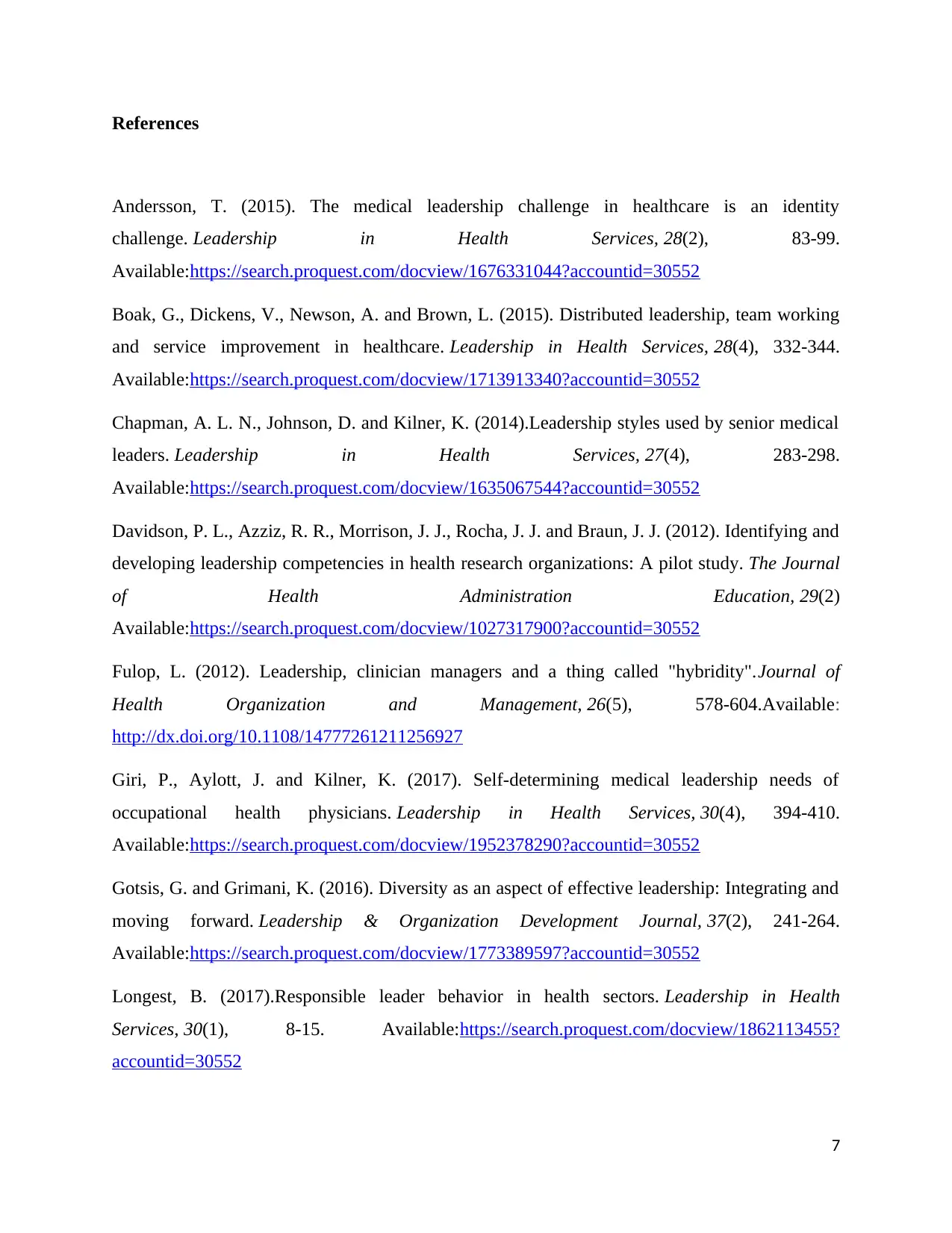
References
Andersson, T. (2015). The medical leadership challenge in healthcare is an identity
challenge. Leadership in Health Services, 28(2), 83-99.
Available:https://search.proquest.com/docview/1676331044?accountid=30552
Boak, G., Dickens, V., Newson, A. and Brown, L. (2015). Distributed leadership, team working
and service improvement in healthcare. Leadership in Health Services, 28(4), 332-344.
Available:https://search.proquest.com/docview/1713913340?accountid=30552
Chapman, A. L. N., Johnson, D. and Kilner, K. (2014).Leadership styles used by senior medical
leaders. Leadership in Health Services, 27(4), 283-298.
Available:https://search.proquest.com/docview/1635067544?accountid=30552
Davidson, P. L., Azziz, R. R., Morrison, J. J., Rocha, J. J. and Braun, J. J. (2012). Identifying and
developing leadership competencies in health research organizations: A pilot study. The Journal
of Health Administration Education, 29(2)
Available:https://search.proquest.com/docview/1027317900?accountid=30552
Fulop, L. (2012). Leadership, clinician managers and a thing called "hybridity".Journal of
Health Organization and Management, 26(5), 578-604.Available:
http://dx.doi.org/10.1108/14777261211256927
Giri, P., Aylott, J. and Kilner, K. (2017). Self-determining medical leadership needs of
occupational health physicians. Leadership in Health Services, 30(4), 394-410.
Available:https://search.proquest.com/docview/1952378290?accountid=30552
Gotsis, G. and Grimani, K. (2016). Diversity as an aspect of effective leadership: Integrating and
moving forward. Leadership & Organization Development Journal, 37(2), 241-264.
Available:https://search.proquest.com/docview/1773389597?accountid=30552
Longest, B. (2017).Responsible leader behavior in health sectors. Leadership in Health
Services, 30(1), 8-15. Available:https://search.proquest.com/docview/1862113455?
accountid=30552
7
Andersson, T. (2015). The medical leadership challenge in healthcare is an identity
challenge. Leadership in Health Services, 28(2), 83-99.
Available:https://search.proquest.com/docview/1676331044?accountid=30552
Boak, G., Dickens, V., Newson, A. and Brown, L. (2015). Distributed leadership, team working
and service improvement in healthcare. Leadership in Health Services, 28(4), 332-344.
Available:https://search.proquest.com/docview/1713913340?accountid=30552
Chapman, A. L. N., Johnson, D. and Kilner, K. (2014).Leadership styles used by senior medical
leaders. Leadership in Health Services, 27(4), 283-298.
Available:https://search.proquest.com/docview/1635067544?accountid=30552
Davidson, P. L., Azziz, R. R., Morrison, J. J., Rocha, J. J. and Braun, J. J. (2012). Identifying and
developing leadership competencies in health research organizations: A pilot study. The Journal
of Health Administration Education, 29(2)
Available:https://search.proquest.com/docview/1027317900?accountid=30552
Fulop, L. (2012). Leadership, clinician managers and a thing called "hybridity".Journal of
Health Organization and Management, 26(5), 578-604.Available:
http://dx.doi.org/10.1108/14777261211256927
Giri, P., Aylott, J. and Kilner, K. (2017). Self-determining medical leadership needs of
occupational health physicians. Leadership in Health Services, 30(4), 394-410.
Available:https://search.proquest.com/docview/1952378290?accountid=30552
Gotsis, G. and Grimani, K. (2016). Diversity as an aspect of effective leadership: Integrating and
moving forward. Leadership & Organization Development Journal, 37(2), 241-264.
Available:https://search.proquest.com/docview/1773389597?accountid=30552
Longest, B. (2017).Responsible leader behavior in health sectors. Leadership in Health
Services, 30(1), 8-15. Available:https://search.proquest.com/docview/1862113455?
accountid=30552
7
Paraphrase This Document
Need a fresh take? Get an instant paraphrase of this document with our AI Paraphraser
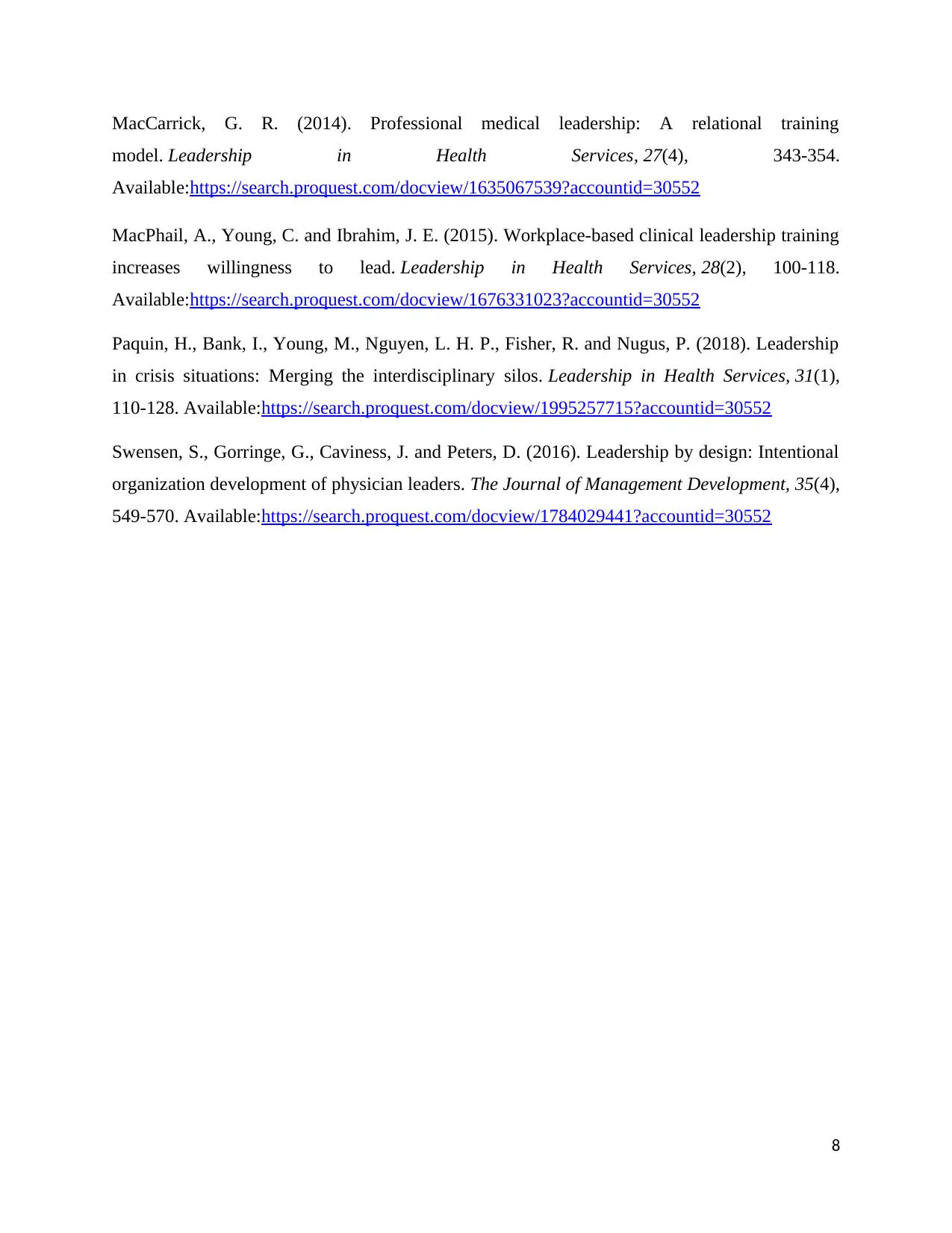
MacCarrick, G. R. (2014). Professional medical leadership: A relational training
model. Leadership in Health Services, 27(4), 343-354.
Available:https://search.proquest.com/docview/1635067539?accountid=30552
MacPhail, A., Young, C. and Ibrahim, J. E. (2015). Workplace-based clinical leadership training
increases willingness to lead. Leadership in Health Services, 28(2), 100-118.
Available:https://search.proquest.com/docview/1676331023?accountid=30552
Paquin, H., Bank, I., Young, M., Nguyen, L. H. P., Fisher, R. and Nugus, P. (2018). Leadership
in crisis situations: Merging the interdisciplinary silos. Leadership in Health Services, 31(1),
110-128. Available:https://search.proquest.com/docview/1995257715?accountid=30552
Swensen, S., Gorringe, G., Caviness, J. and Peters, D. (2016). Leadership by design: Intentional
organization development of physician leaders. The Journal of Management Development, 35(4),
549-570. Available:https://search.proquest.com/docview/1784029441?accountid=30552
8
model. Leadership in Health Services, 27(4), 343-354.
Available:https://search.proquest.com/docview/1635067539?accountid=30552
MacPhail, A., Young, C. and Ibrahim, J. E. (2015). Workplace-based clinical leadership training
increases willingness to lead. Leadership in Health Services, 28(2), 100-118.
Available:https://search.proquest.com/docview/1676331023?accountid=30552
Paquin, H., Bank, I., Young, M., Nguyen, L. H. P., Fisher, R. and Nugus, P. (2018). Leadership
in crisis situations: Merging the interdisciplinary silos. Leadership in Health Services, 31(1),
110-128. Available:https://search.proquest.com/docview/1995257715?accountid=30552
Swensen, S., Gorringe, G., Caviness, J. and Peters, D. (2016). Leadership by design: Intentional
organization development of physician leaders. The Journal of Management Development, 35(4),
549-570. Available:https://search.proquest.com/docview/1784029441?accountid=30552
8
1 out of 8
Related Documents
Your All-in-One AI-Powered Toolkit for Academic Success.
+13062052269
info@desklib.com
Available 24*7 on WhatsApp / Email
![[object Object]](/_next/static/media/star-bottom.7253800d.svg)
Unlock your academic potential
Copyright © 2020–2025 A2Z Services. All Rights Reserved. Developed and managed by ZUCOL.





